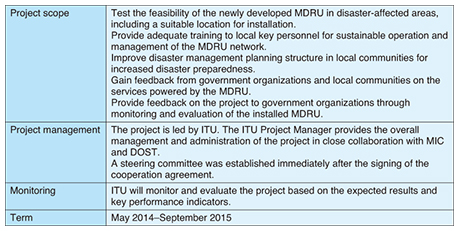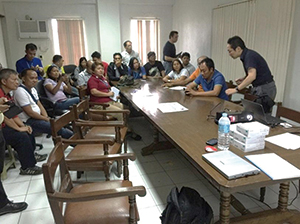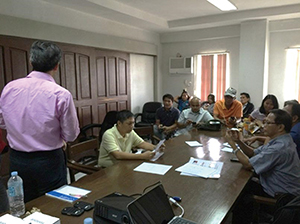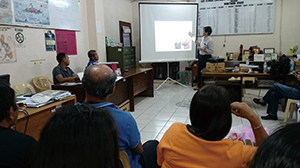 |
|||||||||||||||
|
|
|||||||||||||||
|
Feature Articles: Movable and Deployable ICT Resource Unit—Architecture for Quickly Responding to Unexpected ICT Demand Vol. 13, No. 5, pp. 27–32, May 2015. https://doi.org/10.53829/ntr201505fa6 Overseas Deployment of MDRU: ITU Project in the Philippines, and MDRU Standardization EffortsAbstractThe network facility at the San Remigio municipality on Cebu Island in the Philippines sustained enormous damage from super typhoon Haiyan in November 2013. NTT Network Innovation Laboratories, NTT Communications Corporation, and partners initiated a feasibility study on restoring telecommunication and information and communication technology (ICT) infrastructure damaged by typhoon Haiyan through the use of the Movable and Deployable ICT Resource Unit (MDRU), under cooperation between the Ministry of Internal affairs and Communications of Japan, the Department of Science and Technology of the Philippines, and ITU (International Telecommunication Union). We report on this feasibility study in this article. We also introduce the work being done to standardize the MDRU by NTT Network Innovation Laboratories. Keywords: ITU, disaster relief, overseas deployment 1. IntroductionIn November 2013, NTT won a prize at the ITU (International Telecommunication Union) Telecom World awards being held in Bangkok, Thailand in the category of Broadband in all phases of disaster management and risk reduction for its research and development (R&D) of the Movable and Deployable information and communication technology (ICT) Resource Unit (MDRU) [1]. The effectiveness of the MDRU as an emergency telecommunication platform has since received high commendations from worldwide entities adopting disaster prevention measures, including the nonprofit organization Philippine Central Visayas Information Sharing Network (CVISNET) Foundation, Inc.*, which has been encouraging broad use of ICT in the Philippines. The islands of the Philippines lie in the typhoon corridor in the Pacific area and experience an average of 20 typhoons per year. Typhoon-fed storms and high water are the most critical problems for the Philippine government and its residents. In November 2013, the Visayas region of the Philippines felt the full force of the super typhoon Haiyan. Typhoon-fed storm surges grew to several meters high along the sea coast and caused widespread devastation in the area similar to that of a tsunami. To make matters worse, the communication blackout obstructed attempts to evacuate people. About 6200 people lost their lives in the typhoon, and the number of missing remains at about 1800 [2]. National disasters are on the rise because of climate change, and thus, the United Nations and the international community are continuing efforts to find ways to reduce the risk of natural disasters, prevent the loss of lives, and reduce economic losses. In the process, the Government of Japan and the ITU are collaborating to provide assistance to restore telecommunication connectivity in one of the islands most affected by typhoon Haiyan. On May 13, 2014, the Ministry of Internal Affairs and Communications (MIC), the Department of Science and Technology (DOST), and ITU finalized a cooperation agreement for a feasibility study on restoring connectivity through the use of the MDRU and launched the project.
2. Summary of ITU projectThe ITU project, entitled Feasibility study of restoring connectivity through the use of the Movable and Deployable ICT Resource Unit was inaugurated in May 2014 with the objectives of studying the effectiveness of the MDRU in providing immediate communication infrastructure and IT (information technology) facilities in the worst disaster-stricken areas in Cebu, Philippines, and in studying the viability of the MDRU as a communication solution in the aftermath of a disaster. San Remigio municipality on Cebu Island was the location of the MDRU feasibility study. The municipality consists of 27 barangays, or districts, and has a population of about 64,000. On-site reports of the disaster were gathered manually because all communication networks had been destroyed (Fig. 1). The only source of communications to the government was through a satellite phone under the office of the Mayor.
A summary of the feasibility study is given in Table 1, and a press release announcing that ITU, MIC, and DOST had signed the cooperation agreement, along with a photo of the signees, is shown in Fig. 2. The scope of this feasibility study covers technical testing as well as sustainable operation and management, including the provision of training to local staff and improving the disaster management planning structure in local communities for increased disaster preparedness.
3. Launching the feasibility studyAfter agreement of the cooperation contract was reached, NTT and NTT Communications Corporation (NTT Com) started preparing for the feasibility study in collaboration with local government staff members and residents. The installation of the MDRU, project administration, and support were carried out by NTT Network Innovation Laboratories, NTT Com, NTT Advanced Technologies Corporation, NTT Electronics Corporation, Fujitsu Limited (from Japan), and CVISNET and Diff Sigma Tech Inc. (from the Philippines). NTT Com, Diff Sigma, and Kyocera Corporation respectively provided the MDRU server unit, the MDRU wireless system, and heavy-duty smartphones. The MDRU server unit and the MDRU wireless system used in the project are shown in Fig. 3. They were installed in December 2014 in San Remigio Municipal Hall, and the wireless equipment was installed in a national high school (about 400 m away from the hall), where an evacuation center had been set up. Point-to-point wireless equipment provided a communication link between the municipal hall and the high school. The MDRU team established a wide area Wi-Fi network by employing AP (access point)-AP connection between the Wi-Fi APs at the municipal hall and those at the high school, and a 24-GHz FWA (fixed wireless access) connection between the two buildings [3]. We confirmed through the feasibility study that the MDRU operated effectively in the environment in the Philippines even though there were some differences between Japan and the Philippines.
An example of a use case in the event of a disaster is shown in Fig. 4. In this case, the mayor first called municipal employees on the phone to get information about the disaster. Then, the municipal employees took pictures of the disaster-affected area with a smartphone and saved them on the server in the MDRU. This enabled the mayor to gain a visual understanding of the disaster affected area by looking at the pictures stored in the server. The mayor then instructed employees at the municipal hall to provide relief goods in the affected area, and then he reported on the situation to the central government.
We plan to continue working to improve some operation rules, the connectivity, and the specifications of the MDRU by conducting a feasibility study of each use case in order to meet the needs of municipal employees and local residents. The scope of this feasibility study included not only technical testing but also the provision of training. A training session on installing and running the MDRU applications [4] in the smartphone was held for the residents of San Remigio (Photos 1 and 2). Of 30 people who attended, more than 90% of them said that the MDRU phone was “easy to use” or “very easy.” The briefing session is shown in Photo 3, in which the essential points and the importance of the MDRU feasibility study were discussed with the engineers in San Remigio, and the technologies used in the MDRU project were explained. We demonstrated that the MDRU was easy to use for residents in San Remigio through this feasibility study. The MDRU will need to be equipped with a power generator when a long-term power outage occurs, although some UPSs (uninterruptible power supplies) have already been mounted on MDRUs. We plan to confirm the feasibility and review the rules and operation of the MDRU with local residents.
4. StandardizationThe Japanese government led the discussion on establishing a Focus Group (FG) on disaster relief in ITU-T (ITU-Telecommunication Standardization Sector), and it was agreed to establish the Focus Group on Disaster Relief Systems, Network Resilience and Recovery (FG-DR&NRR). Many Japanese use cases including MDRU had been proposed for the deliverables of FG-DR&NRR during two years of discussions and standardization efforts. Since the FG activities were finalized in June 2014, we have been working on finalizing an ITU-T Recommendation of the MDRU in Study Group 15 by 2016 because ITU-T standardization is the crucial element for promoting broad use of the MDRU throughout the world [5]. The technical report entitled Requirements on the improvement of network resilience and recovery with movable and deployable ICT resource units that describes the immediate lessons learned after the Great East Japan Earthquake are already available on the ITU-T FG-DR&NRR website [6]. 5. Future plansNTT and NTT Com are working to promote broad use of the MDRU throughout the world for disaster relief after large-scale disasters and to expand its use in other applications such as in prompt provision of ICT services in developing countries lacking ICT infrastructure. AcknowledgmentsThe MDRU project is a joint R&D effort between NTT, Tohoku University, Fujitsu Limited, and NTT Com. This R&D project is partially supported by the Ministry of Internal Affairs and Communications of Japan. References
|
|||||||||||||||










